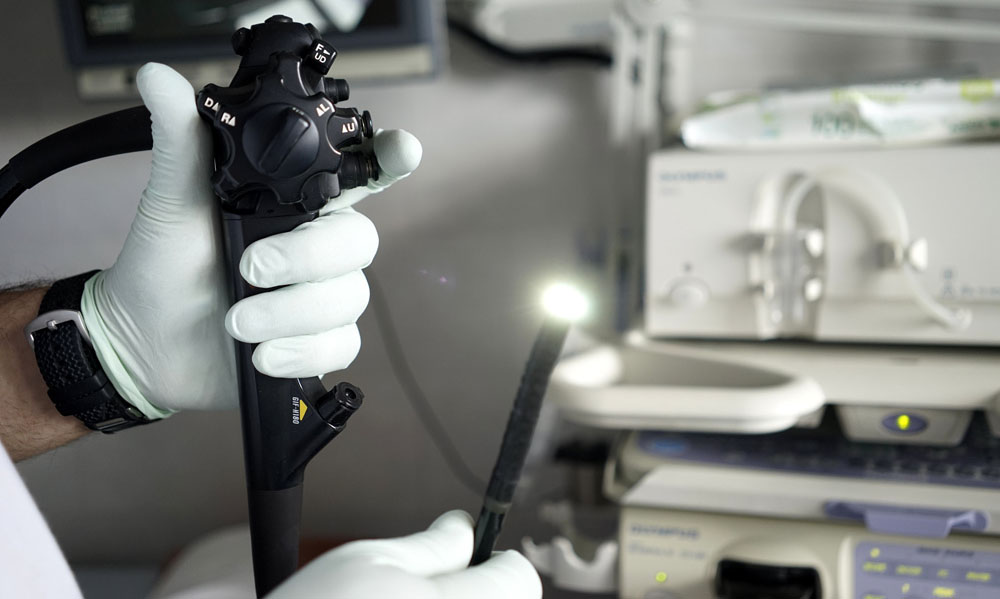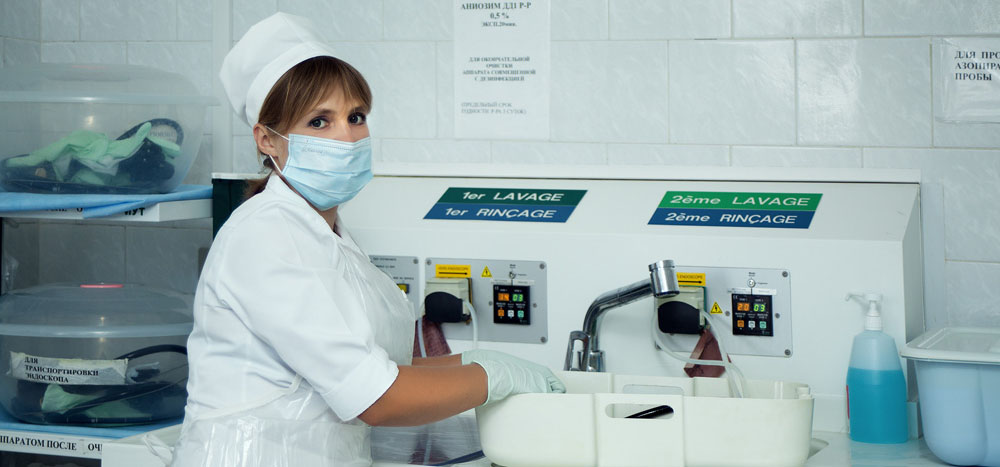
Endoscopic investigations
The department performs diagnostic and treatment gastroscopy, colonoscopy and bronchoscopy with the use of high-technology video information systems of expert class “ЕVIS EХERA 2” and “ЕVIS EХERA 3”completed with video endoscopes having highly spectral and magnification functions, and also photo-archiving of the detected pathology. The equipment of Endoscopic Department substantially expands diagnostic capabilities, to simplify the performance of endoscopic operations, to receive the images with the finest details, to detect and classify the structural changes of visceral mucosa for the purpose of early precancerous pathological detection.
- The department renders the wide range of endoscopic investigations and manipulations, inclusive of:
- videoesophagogastroduodenoscopy (VGDS) – to estimate the state of esophageal, stomach and duodenal mucosa;
- videotracheobronchoscopy (VTBS) – the examination of trachea and bronchial tree;
- videocolonoscopy (VCS) — the status assessment of colonic mucosa;
All diagnostic manipulations are combined with the sampling for laboratory investigations (biopsy).
Serious consideration is paid to the morphological diagnostics of the diagnosed endoscopic pathology. Practically 100% of investigations are associated with mucosal biopsy for cytological and histological investigations with the performance of express-tests.
Endoscopic tissue biopsy, which is performed during the investigations of gastrointestinal tract, is usually taken from any abnormal area. This standard makes it possible to diagnose early GIT cancer and to implement its’ successful treatment. The investigation is aimed to make certain of the absence of malignant symptoms. If cell degeneration is diagnosed at the very beginning, in this case it is possible to realize early endoscopic removal without surgical treatment.
Particular attention is focused on polyp detection and elimination with the use of advanced electrosurgical complexes while applying both traditional techniques and electrosurgical dissection of the abnormal area located in sub-mucous membrane.
Radiological electrosurgical operations are held in biliary system pathologies (gall bladder and biliary ducts); these involve retrograde cholangiopancreatography, papillosphincterotomy, mechanical lithotripsy and calculus extraction from choledoch duct.
We have implemented endosonography and now actively use it to diagnose and identify topics and verifications of gastrointestinal sub-mucosal masses and pancreatic-biliary zone pathologies by applying three-dimensional ultrasound transducer or ultrasound gastroscope, which is required to prognosticate process development and to specify patient surveillance.
 A large number of investigations, both gastro- and colonoscopy, are conducted with intravenous anesthetization to eradicate patient’s subjective discomfort in the course of manipulation and to implement more qualitative examination of all the areas of gastrointestinal tract.
A large number of investigations, both gastro- and colonoscopy, are conducted with intravenous anesthetization to eradicate patient’s subjective discomfort in the course of manipulation and to implement more qualitative examination of all the areas of gastrointestinal tract.
The department has the updated pool of photo and computer data: photographic material for all the pursued investigations is deposited at the unified video archive based on the centre’s computer network, resulting in conclusive tracing of the course of disease.
At the present moment, we have inculcated single balloon enteroscopy that allows for highly effective visual diagnostics of the deep small intestinal areas, which are beyond the reach during usual investigations and, thus, providing target sampling for morphological examination and, where applicable, implementing medical intervention.

- Treatment of chronic bronchitis, foreign body extraction, polyp removal from gastrointestinal tract and common bile duct stone elimination, which makes it possible to elude major surgical procedures.
- The administration of drug substances in bronchial tree (therapeutic VTBS (videotracheobronchoscopy)) exerts direct impact on bronchial mucosa in chronic bronchitis.
- Endoscopic polyp extraction represents reliable and unpainful minor surgical procedure, which resolves huge problems. 96% of them are performed on outpatient basis with no need for hospital stay.
- Radiological endoscopic biliary duct manipulations (ERCP with calculus retrieval).
- 100% Helicobacter Pylori diagnostics (2 methods: cytological and histological).
Videogastroduodenoscopy
PEDIATRIC DIAGNOSTIC VIDEOGASTRODUODENOSCOPY IS PERFORMED ONLY BASED ON THE REFERRAL BY PEDIATRICIAN OR PEDIATRIC GASTROENTEROLOGIST, FROM 3 TO 13 YEARS OLD ONLY WITH IV SEDATION.
IV SEDATION AT THE AGE FROM 14 TO 18 – AT THE PATIENT’S REQUEST.
ATTENTION! If you are intended to undergo the given investigation with intravenous anesthesia, it is necessary to consider the preparation for general anesthesia of which the anesthesiologist is to inform you during preliminary counselling.
Colonoscopy
ATTENTION! PEDIATRIC DIAGNOSTIC VIDEOCOLONOSCOPY IS PERFORMED ONLY BASED ON THE REFERRAL BY PEDIATRICIAN OR PEDIATRIC GASTROENTEROLOGIST OF RADC, AT THE AGE FROM 10 TO 18 YEARS OLD WITH IV SEDATION, EXCEPTIONS MAY BE GRANTED when the decision I taken on case-by-case basis.
ATTENTION! If you are intended to undergo the given investigation with intravenous anesthesia, it is necessary to book the appointment to anesthesiologist beforehand, and to consider the preparation for general anesthesia of which the doctor is to inform you during counselling. Conducting anesthesia and anesthesiologist’s consultation are provided only on payment basis.
PREPARATION for the investigation IS AGREED UPON WITH ATTENDING PHYSICIAN.

